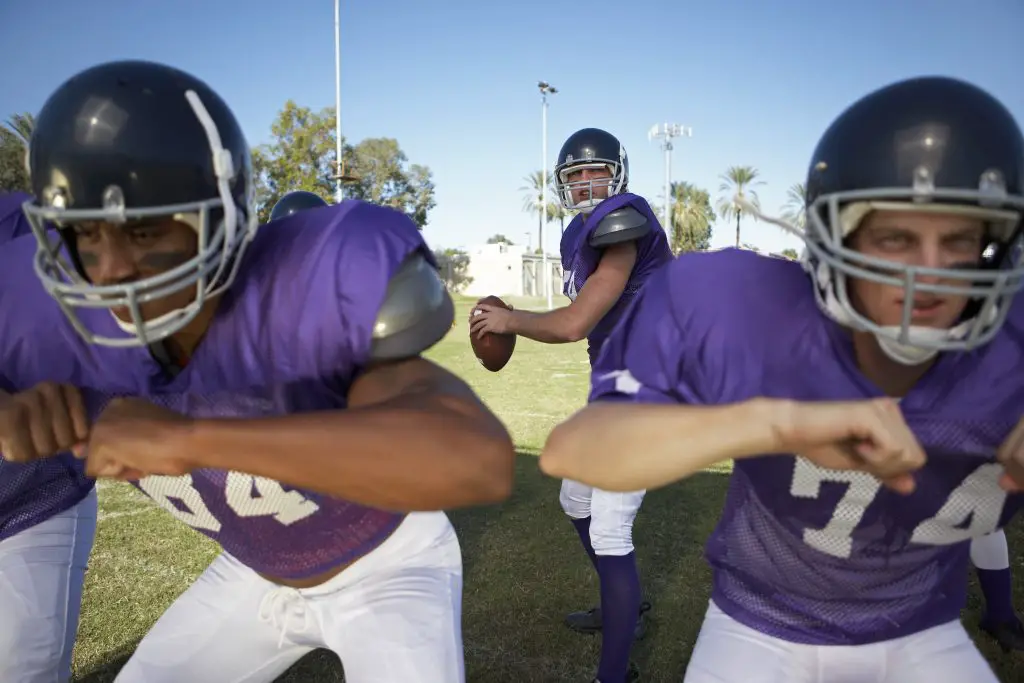The quick answer is yes, and no.
It depends on the competition you’re talking about: youth, high school, college, or NFL (and other professional leagues).
In all competitions except NFL, quarterbacks DO NOT have headsets in their helmets. And even in the NFL, it is restricted.
Only two players can have a headset in their helmet in the NFL, one offensive and one defensive. And it’s only a headset. There’s no microphone, so both football players can hear what the coach says but cannot talk back.

And several other rules apply to the use of headsets in helmets. But first, we’ll take a short history lesson before taking a deeper dive into the use and non-use of helmets in helmets.
NFL History Snapshot
In 1956, two Cleveland Browns fans fitted a helmet with a radio receiver to allow the coach to talk to his quarterback. Hall of Fame coach Paul Brown, then coach of the Browns, used it successfully in a pre-season game against Detroit.
But the opposition coach noticed its use and complained to the league. The league under Commissioner Bert Bell immediately banned the helmets for use between the coach and quarterback but allowed coaches to continue communicating between themselves using headsets.
In 1994, some 38 years later, the ban was lifted, and headsets were installed in quarterbacks helmets. Another 14 years passed until, in 2008, the league allowed radio in the helmet of one only defensive player.
The on-field two headset helmet rule remains to this day. You can tell them by the green dot on the back of the helmet.
But there are other restrictions on their use aside from the number used.
Professional League Rules
The rules do vary between leagues, but generally, the following applies:
- The sideline can talk to the quarterback, but the booth up top can’t.
- Communication is limited to the quarterback’s helmet.
- Only one quarterback is permitted on the field.
- With fifteen seconds left on the play clock, the frequency cuts out. It means the coach has just 25 of the 40-second play clock to relay his messages to his on-field player before the cutoff.
- One team has to turn off their system if the other team’s system goes down.
The last two rules have been removed by the National Football League and Canadian Football League.
So communication in these leagues is not limited:
- either during the rundown of the play clock
- or if the other team’s system goes off.
Additionally, one player is allowed on the defensive team (often the middle linebacker) to have a headset with communication managed by the teams themselves.
While only two players on the field can wear helmets with speakers (but no microphones), up to three quarterbacks and two defensive players on the team can have speakers in their helmets.
Helmet Headset Rules in Non-Professional Football
In the NCAA, headsets in helmets are banned just as they in youth and high school football. In addition, players on the field are not allowed to talk to the sideline via communication technology.
So these competitions continue to use the age-old skill of hand signals or picture boards to communicate between the Head Coach and the players. But this means they continue to experience the downsides of:
- having to learn the many and sometimes complicated hand signals etc. when they could be training
- misunderstanding the signals and confusing the team
FAQ’s
How are the speakers set up in the helmet?
The standard NFL helmet doesn’t have any communication equipment. The speakers are only installed in the helmets of the quarterback and the designated defensive player.
The headsets are light, durable, and comfortable, with the speakers located on the sides of the helmet, giving direct access to the ears, which keeps the sound quality clear and crisp.
They also reduce the noise level to lessen the impact of the crowd’s roar during games and work best at lower volumes, so there’s no need to crank up the volume to hear what the coach or teammates say.
Can’t the opposition listen in to the communication?
In the early days, with the analog frequencies in use, it was possible. So it came down to an agreement between the teams not to ‘listen in”. Unfortunately, the frequencies were sometimes the same as local radio stations or even for half-time entertainment. It meant the teams had to remember to turn off their headsets outside of playing time.
In 2012 digital systems replaced outdated analog systems.
In the same year, the NFL didn’t renew their sponsorship deal with Motorola to supply wireless headsets that had been in place since 1999. Instead, the NFL used unbranded headsets for two seasons until they signed a sponsorship deal with Bose in 2014. The Bose headsets use noise-canceling technology, and the microphone only picks up the voice of the person speaking into it.
But there was still the problem with open frequencies.
It wasn’t until 2016 the problem was resolved.
The NFL registered an exclusive and encrypted frequency range with the FCC (Federal Communications Commission) that allows up to ten coaches per team to talk privately without anyone listening in. The secure range also applies to the communication from the coaches to the two on-field players.
Another benefit is that the encrypted frequency from the FCC is in a much higher range than that used for radio broadcasts and other commercial uses. It means that signals no longer cross with those from unwanted sources.
Can Any Coach Talk To The Quarterback Or Defensive Player?
A definite no. The coach talking to the player must be a sideline coach.
The coach in the booth cannot talk to any player on the field through a speaker in a helmet.
The coach communicating with the player has the same on-field view as the player and not the more favorable birds-eye view from the booth.
However, teams can get around this rule. If the team’s play-caller, like the Offensive Coordinator, is in the press box, he can advise the play to an assistant coach on the bench, who then relays it to the quarterback. There is a slight delay, though, for the quarterback to hear the message.
Do NFL players’ radio earpieces stay on during plays?
The radios stay on only until the play clock has fifteen seconds to go, OR the ball is snapped, whichever comes first.
